Hungary – Central and North (Budapest, Szolnok, Eger) October 3-4, 2019
TOKAJ WINE REGION HISTORICAL CULTURAL LANDSCAPE
The name of Tokaj is identified with wine all over the world. In this wine region situated in the north-east part of Hungary they found the fossil of the leaf of an ancient vine type, which is regarded as the common ancestor of the present vine varieties. So it can be said that the vine is truly indigenous and natural to Tokaj. The intricate pattern of vineyards, farms, villages and small towns, with their historic networks of deep wine cellars, illustrates every facet of the production of the famous Tokaj wines, the quality and management of which have been strictly regulated for nearly three centuries.
Tokaj Village. 54 kilometers from county capital Miskolc, It is the centre of the Tokaj-Hegyalja wine district where Tokaji wine is produced.
The wine-growing area was first mentioned by the name Tokaj in 1067. The town itself was first mentioned in documents in 1353. Its first castle was a motte, which was destroyed during the Mongol invasion of Hungary. By the 14th century the town already had a stone castle, belonging to the Diósgyőr estate.
After the Austro-Hungarian Compromise of 1867 the town prospered, but when the world wars came, it suffered a lot, lost its importance and its town status. Even its role in wine trade was taken over by Sátoraljaújhely.
Tokaj was granted town status again in 1986 and it started to prosper again. Now the town is a popular tourist attraction.
Tokaj wine region is a historical wine region located in northeastern Hungary and southeastern Slovakia. It is one of the seven larger wine regions of Hungary.
The region consists of 28 named villages and 11,149 hectares of classified vineyards, of which an estimated 5,500 are currently planted. Tokaj has been declared a World Heritage Site in 2002 under the name Tokaj Wine Region Historic Cultural Landscape. However, its fame long predated this distinction because it is the origin of Tokaji aszú wine, the world’s oldest botrytized wine.
Miskolc (pop 162,000)
In northeastern Hungary, it is known for its heavy industry. It is the fourth largest city in Hungary (behind Budapest, Debrecen, and Szeged).
The city developed in a dynamic way, but during the Ottoman occupation of most of Hungary the development of Miskolc was brought to a standstill. The Turks burnt Miskolc in 1544 and the city had to pay heavy taxes until 1687. It was during these years that Miskolc became an important centre of wine-growing. By the end of the 17th century the population of the city was as large as that of Kassa, and 13 guilds had been founded.
During the war of independence against Habsburg rule in the early 18th century, The imperial forces sacked and burnt the city in 1707. Four years later half of the population fell victim of a cholera epidemic. Miskolc recovered quickly, and another age of prosperity began again. In 1724,
These years brought prosperity, but the cholera epidemic of 1873 and the flood of 1878 took many lives. Several buildings were destroyed by the flood, but bigger and grander buildings were built in their places. World War I did not affect the city directly, but many people died, either from warfare or from the cholera epidemic.
After the Treaty of Trianon, Hungary lost Kassa (today Košice, Slovakia) and Miskolc became the sole regional center of northern Hungary. This was one of the reasons for the enormous growth of the city during the 1930s and 1940s.
Early in World War II Hungary became an ally of Nazi Germany. Unhappy with the Hungarian government, the Germans troops occupied Hungary on March 19, 1944 and put the anti-semitic Arrow Cross Party in charge of the government. Jews in Miskolc and elsewhere were ordered to wear yellow stars on their clothing. Under the supervision of Nazi SS-Obersturmbannführer Adolf Eichmann, “deportations” from Miskolc began on June 11 or 12th, 1944. Over 14,000 Jewish adults and children were sent by cattle car to Auschwitz, where most were gassed on arrival. After the war Jews who survived the holocaust returned to Miskolc hoping to reclaim their land and possessions. Over 130 were rounded up by members of the local Arrow Cross Party and summarily murdered. The Jewish cemetery on a hill overlooking Miskolc has a memorial for them. It includes the 10 commandments, carved in stone, all written in Hebrew except Thou shall not kill, which is written in Hungarian.
The preparation for World War II established Miskolc as the national centre of heavy industry, a position the city maintained until the 1990s. Tourist destinations in Miskolc include Tapolca, Lillafüred and Felsőhámor. Tapolca has a park with a boating pond and the unique Cave Bath. Lillafüred and Felsőhámor are pretty villages in a valley surrounded by mountains and forests; their sights include the Hotel Palace on the shore of the Lake Hámori, the Szinva waterfall (the highest waterfall of the country), the Anna Cave and the István Cave.
CAVES of AGGTELEK KARST and SLOVAK KARST
This is a UNESCO World Heritage site consisting of 712 caves spread out over a total area of 55,800 ha (138,000 acres) along the border of Hungary and Slovakia. This UNESCO World Heritage site includes seven components. They are Aggtelek National Park, Szendrő-Rudabánya Hill, and Esztramos Hill in Hungary, and Dobšinská Ice Cave, Koniar plateau, Plešivec plateau, and neighbourhood of Silica and Jasov in Slovakia.
Aggtelek National Park in north-eastern Hungary was established in 1985 primarily to protect surface formations and caves. Seventy-five percent is covered with deciduous forest with clearings scattered about like a mosaic, areas of rock and the hillsides dotted with rocky outcrops. It provides a habitat for rare plants, a rich insect world and more than 220 species of local birds. It contains Central Europe’s largest cave system.
Caves included are:
Baradla-Domica Cave complex is 21 km (13 mi) long with approximately one fourth of that on the Slovak side and the rest in the Hungary. The first written mention of Baradla cave dates back to 1549 and from 1920 it serves as a tourist attraction. Ján Majko discovered Domica Cave (Slovak part of the complex) in 1926 and the tourist circuit opened to public in 1932 has more than 1,700 metres (5,600 ft). Cave was inhabited as far as 5000 BC and is an important archeological site of Bükk Culture. Temperature in the Slovak part varies between 10 and 12.3 °C (50.0 and 54.1 °F) with a humidity above 95%.
I went on the tour of this cave, unfortunately only in Hungarian but there was a fellow who had lived in the US for 26 years and translated. The cave had been open for centuries and people were allowed to break off stalagtites and sell them so many of the large ones were gone. The explored part of the cave is 25kms long with 7kms in Slovakia. There are several large chambers, the highest 18m with an entrance in the roof accessed by a rope. It led to several other passages. The best parts of the cave were several columns and a sea of tiny stalagtites on the roof of most of the passages. HUF2400, 1700 reduced
OLD VILLAGE of HOLLÓKÕ and its SURROUNDINGS (pop 380)
91kms NE of Budapest, this Palóc ethnographic village is a living example of agricultural life before the 20th century. The farms have been handed down through generations preserving ancient methods of farming, seed trees, rare plants and very narrow plots of land. Its name means “Raven stone” in Hungarian. It lies in a valley of the Csehat Mountains, mostly low hills.
History. In the middle of the 13th century, in the aftermath of the Mongol invasion of 1241, construction of Hollókő castle first began as a means to protect the area against future attacks. At this time, the area around Hollókő was held by the Kacsics noble clan. The castle was first mentioned in records in 1310. The original village was built just below the castle walls. The Ottomans captured the castle in 1552 and for the next 150 years, control alternated between Ottoman and Hungarian forces. At the end of the Ottoman era (1683) the castle and the village were finally abandoned and the present village grew up below. Many of the existing houses were first built around this time.
The traditional Palòc houses were originally wood with thatch roofs that have had to be rebuilt many times throughout the years due to periodic fires, the last being in 1909, when they were all rebuilt in adobe and tile roofs in a folk architectural style.
The people speak their own dialect. On special occasions, they dress in traditional clothes that indicate their marital status: women wear a bodice, many skirts to just below the knee and bonnets, the men, white shirts, felt trousers and waist coats.
In 1987, the village, castle ruins, and surrounding area were inscribed as a UNESCO World Heritage Site. The village is surrounded by a 141-hectare conservation area.
Sights. The protected part of the village – Lajos Kossuth and Sándor Petőfi streets, 67 houses. The cobble street splits and then rejoins to enclose some houses and the church. All are very well-maintained, whitewashed plaster with brown trim and stone basements/foundations. The uphill houses have basement entrances. Many are extremely large.
St. Martin Roman Catholic Church. Built in 1885, it has a 3-story wood tower with a double cross on top.
Hollókő Castle. Sits high above the west end of the town. Holds special exhibitions.
Village Museum, Post Museum, Doll Museum, The House Of The Weavers
Trails: 4 trails branch out from the town.
1. Castle Trail. 1.2kms long, it climbs to the castle and then circles back down to the village.
2. Raven Trail. 4.5kms long, it is a botanical study trail that tours castle hill and the seed-tree pasture.
3. Hollókő Trail. Crosses a 30m long wooden bridge and goes through the forest along the bottom of the valley.
4. Next to the Garden Trail. Follows the creek along the gardens with meadows, gardens and fruit trees. There are several small ponds once used to soak hemp and for washing.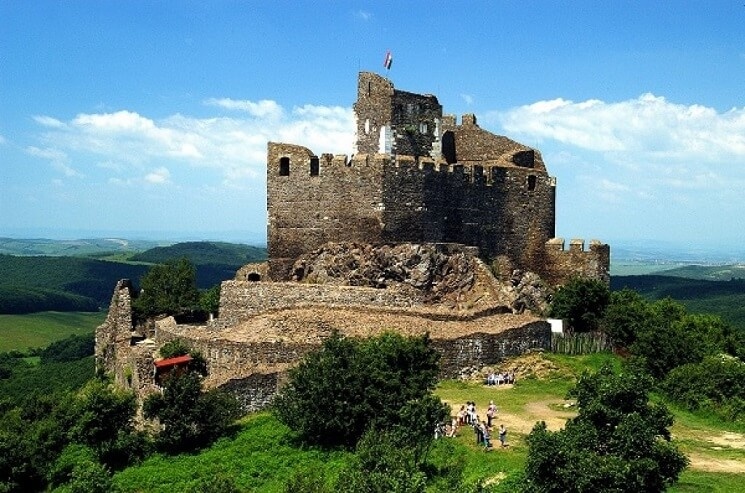
VISEGRAD
I had wanted to go here but it was a long detour out of the way. As I wanted to return to Slovakia, there was no bridge crossing of the Danube except back at Esztergom.
Mediaeval Royal Seat and Parkland at Visegrád. Tentative WHS: (28/12/2000)
ÖDÖN LECHNER’S INDEPENDENT PRE-MODERN ACHITECTURE (26/05/2008)
Ödön Lechner (1845 – 1914) was a Hungarian architect, one of the early representatives of the Hungarian Secession movement related to Art Nouveau in the rest of Europe. He decorated his buildings with Zsolnay tile patterns inspired by old Magyar and Turkic folk art. The Magyars were a people that came from the east, which explains the eastern-like appearance of Lechner’s buildings. He combines this with the use of materials modern for his time, such as iron.
His work was submitted in 2008 for inclusion on the World Heritage List. Lechner studied at Berlin’s Schinkel Academy and in Italy for one year. In the boom years of the 1870s, construction of buildings lining the ring roads on the Pest side of the Danube occurred. The commissions were primarily apartment houses in which Lechner worked in the prevailing historicist style, drawing on neo-classical influences from Berlin and the Italian renaissance.
Between 1875 and 1878 he worked in Paris and familiarised himself with the emerging art nouveau style. He took part in the design and renewal of seven castles. From 1879 he returned to work as before in Hungary and after 1890 his style moved away from historicism to embrace the more modern trends of the day. Lechner’s final commission was for the Gyula Vermes house in the fifth district of Budapest in 1910–11.
Hungarian secessionist style. Lechner aimed to form a national style, using motifs from Hungarian folk art in the decoration of his buildings as well as incorporating architectural elements from eastern cultures like Persia. Changing directions and curved shapes, terracotta tiling with façades covered with Zsolnay terracotta. The pinnacle of Lechner’s work is represented in the Postal Savings Bank (the headquarters of the National Bank of Hungary at present) completed in 1901. The building’s orgy of colours and forms build off art nouveau influences and the emerging European style at the turn of the century, marrying these ideas with Hungarian motifs and eastern forms to create a unique style.
A tentative WHS (26/05/2008)
1882 Szeged City Hall
1882–84 Hungarian Railway Pensioners Building (Palais Drechsler), Budapest
1885–86 Nagybecskerek City Hall, Kingdom of Hungary (today’s Serbia),
1891–97 Saint Ladislaus Church, Kőbánya, Budapest
1893 Kecskemét City Hall
1896 Budapest Museum of Applied Arts
1896–99 Geological Institute, Budapest
1899–1901 The Postal Savings Bank building, Budapest
1903 Tomb of Schmidl family, Kozma Street Cemetery, Budapest
1906–08 Royal Catholic Gymnasium in today’s Bratislava
1907–13 The Church of St. Elizabeth (Blue Church) in Bratislava
1909–12 Saint Ladislaus Church in South Norwalk, Connecticut, USA
1914–1915 Szent László Gimnázium, Budapest
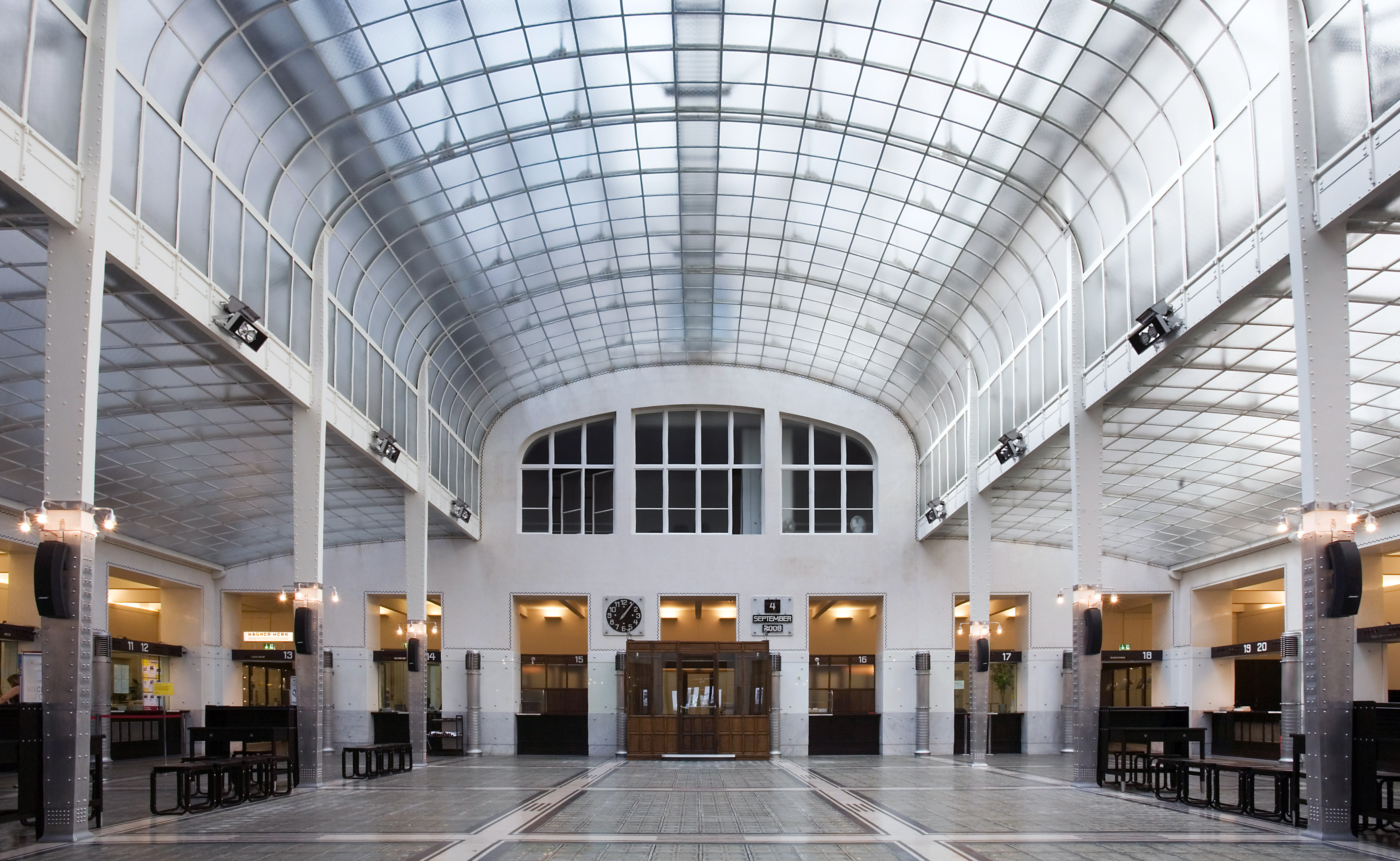
Postal Savings Bank, Budapest
BUDAPEST
Cut in two by the Danube, with hills and valleys on one side (Buda side), and plains on the other (Pest side), connected with a series of graceful bridges spanning the river, Budapest offers a unique panorama. The characteristically Baroque façades of Buda Castle Quarter have retained a distinctly medieval atmosphere, while the Pest side has kept a large extent of its strikingly uniform historicist and art nouveau architecture – enriched with public buildings of outstanding importance – fitted into a city structure of grand boulevards and avenues, including Andrássy Avenue and its surroundings as a key feature.
World Heritage Sites: Budapest, including the Banks of the Danube, the Buda Castle Quarter and Andrássy Avenue
Csepel Island. The largest island on the Danube River, it is 48 km long; its width after 3–km sections of bifurcation and rejoining (confluence) is 6–8 km. Its area comprises 257 km² and its population is 165,000.
It features Hungary’s tallest structure, Lakihegy Tower, a 314 metres (1,030 ft) radio mast used today intermittently for power network control purposes.
Feny Street Market. This is a large enclosed market, more like a small 3-story shopping mall, on the old fashioned side.
Matthias Church. A 3-nave church with arches and all the ceilings the same height, it is surprisingly bright for having only small windows on the left. It is completely painted inside with geometrics and floral patterns. The multi-lobed columns, ribs, pulpit and arches are each a different design. There are some murals about ⅔ of the way up the walls, in the two wonderful chapels at the front and on the back wall. There are several gothic elements – the confessional, canopy of the pulpit and the main altar. Climb up to the two galleries on the left with the museum.
The outside is white limestone with a single 1420 gothic tower and a coloured geometrics on the roof.

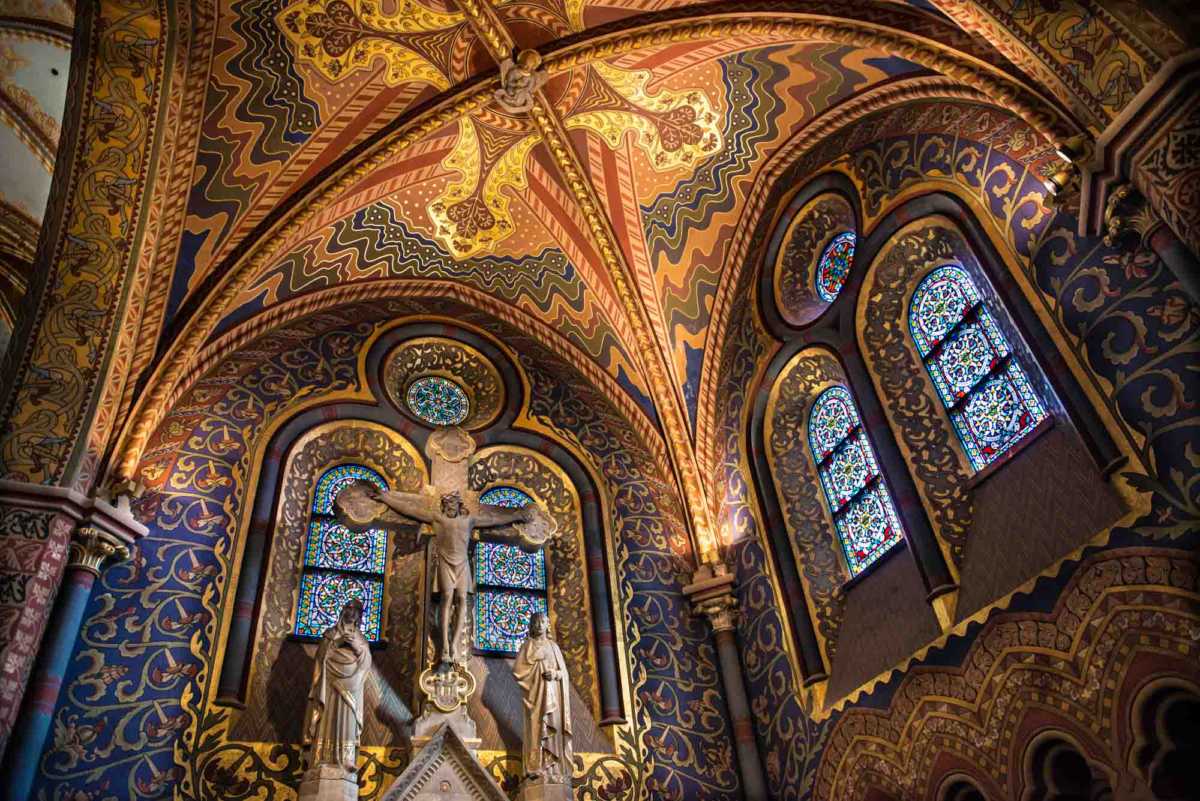
This church and the large square outside are tourist central. A plague column is opposite the front. 1200 reduced
House of Houdini. Seen by guided tour with a magic show. 24HUF
Sándor Palace. The official residence of the President of Hungary, and the seat of the Office of the President. It has served as both since 2003. Sándor Palace is the 37th biggest palace in present-day Hungary.
The palace is situated at Szent György tér 1-2 (St. George Square) in Buda, immediately north of the Buda Castle complex, which was the former residence of the kings and governors of Hungary.
This huge palace has the Hungarian National Gallery with exhibit on surrealism with Dali and Magrite.
Buda Castle. All that is left are the foundations, half cleaned up and half a wreck that isn’t visited.
Budapest Castle Hill Funicular. This is an escalator on one side going up and stairs down. Free
Liberty Statue. On the Gellért Hill, it commemorates those who sacrificed their lives for the independence, freedom, and prosperity of Hungary. It was first erected in 1947 in remembrance of what was then referred to as the Soviet liberation of Hungary during World War II, ending the occupation by Nazi Germany. Its location upon Gellért Hill makes it a prominent feature of Budapest’s cityscape.
The 14 m tall bronze statue stands atop a 26 m pedestal and holds a palm leaf. Two smaller statues are also present around the base.
At the time of the monument’s construction, the defeat of Axis forces by the Red Army was officially proclaimed “liberation”—leading to the original inscription upon the memorial (both in Hungarian and Russian): translated to read, “To the memory of the liberating Soviet heroes the grateful Hungarian people 1945”. Over the following years, public sentiment toward the Soviets decreased to the point of revolution, which was attempted and temporarily succeeded in 1956 and subsequently damaged some portions of the monument. After the 1989 transition from communist rule to democracy, the inscription was modified to read: Translated from Hungarian: “To the memory of those all who sacrificed their lives for the independence, freedom, and prosperity of Hungary”. The Russian language version of the tribute was removed in its entirety.
Hotel Gellért. In a truly grand 5-story building, the grand arched entrance is topped by a high dome. Two towers flank the south side and a copper roof is on the NW corner. All the rooms have balconies.
I then crossed over to Pest on the wonderful green steel girder bridge with its 2 piers and gothic towers topped by eagles.
Central Market Hall. With a red/cream brick exterior and colourd geometric tiled roof, this is one of those magnificent steel girder markets. It is huge with 3 aisles and a small crossing area. Buy all things food.
Matyas Pince Restaurant. Dating from 1904, it serves traditional food and was empty, ie no custuomers.
Százéves Étterem Restaurant. Dating from 1831, it is the oldest restaurant in Pest and serves traditional food. Not very busy.
Orthodox Cathedral of Our Lady. Unfortunately closed for renovation.
Puskin Mozi. This movie theatre is in a grand old building with a lovely old fashioned lobby. It has the 225 seat Metropolis Theatre, 71 seat Amarcord theatre and the 68 seat Korhinta theatre. Tickets 1600
Dohány Street Synagogue. The largest synagogue in Europe and second biggest in the world. 50,000-100,000 Jews live in Budapest, 70% live in city proper. 20 synagogues in Budapest. 3000 seats with about 300/service as many are mixed marriages and children can’t be educated in Jewish schools. Built 1854-59 but part of massive complex: 2 synagogues, gardens, museum. many unique rooms (studio and dressing rooms of Rabbi). Style is Moorish Revival as are many synagogues. Lovely stained glass window on each level all with a six-sided star motif. Ceilings painted in Moorish designs. Brass railings.
Sephardic Jews from Spain occupied by Arabs and had a Mediterranean culture. Askenazie, neologues (not conservative or orthodox) that evolved in second half of 19th century. 164 ft long and 14- feet high seating over 1,000. Has tw 9 baoc9h8es 0er side. Arc contains Torah scrolls made on parchment in Hebrew – contain the first 5 books of Old Testament. Reading must be done in Hebrew but Rabbi speaks in Hungarian.
Unusually has an organ as accepted in neologue congregation. Can be used in public concerts. Present replaced in 1901, 1931 and 1997. 4 keyboards and 5,030 air tubes.
Synagogue even has a cemetery. 10,000 died in Budapest ghetto. 2,250 buried in cemetery. Holocaust memorial of Remembrance has 7 separate memorials with the Tree of Life created in 1990 in stained glass and silver with 30,000 small metal leaves, each with the names of those killed in Holocaust.
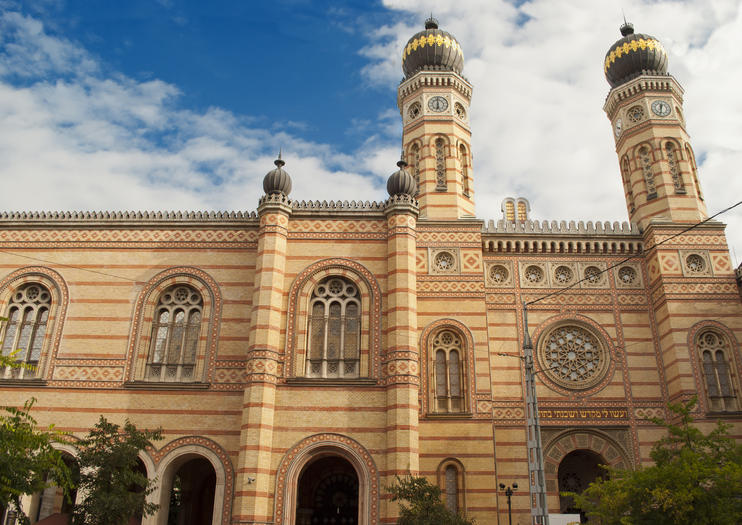

Seen by guided tour in several languages. Museum in the basement tells the story of the Budapest ghetto established in March 1945 when the Nazis occupied Hungary and liberated in January 1945. Over 3000 bodies lying around in the streets and 2,281 buried in cemetery in the synagogue. 4500 HUF (definitely not worth the price (you can see the gardens and tree of life from the street and there is little that is special inside. Read about Jews in Hungary and the synagogue and get more information than what is provided in the very short tour given while you sit in pews)
Urania National Film Theatre. 5-story building with Moorish arches and pillars.
Gerbeaud Café. Established in 1858, its prices were over the top. It sits on a large square and has sidewalk seating not like the last two restaurants.
St. Stephen’s Basilica. This is a huge church with 2 bell towers and a giant dome. Inside is baroque with a lot of marble, gilt and ornamental ceilings. You can only enter one small corner of the church. Free
Corinthia Grand Hotel Royal.
Ronald Reagan Statue. This 2m tall bronze statue of Reagan is of him walking. It sits on the corner of Liberty Square and has his signature in bronze on the paving.
Shoes on the Danube Bank sculpture. Honours the Jews who were killed by fascist Arrow Cross militiamen in Budapest during World War II. They were ordered to take off their shoes, and were shot at the edge of the water so that their bodies fell into the river and were carried away. It represents their shoes left behind on the bank.
The monument is located on the Pest side. 3,500 people, 800 of them Jews were shot into the Danube during the time of the Arrow Cross terror. Most of the murders along the edge of the River Danube took place around December 1944 and January 1945, when the members of the Arrow Cross Party police (“Nyilas”) took as many as 20,000 Jews from the newly established Budapest ghetto and executed them along the river bank.
This is 116 individual bronze cast shoes, many in pairs and all disheveled. They sit on the edge of the river on the side of a cobble promenade. The plaque behind says “ TO THE MEMORY OF THE VICTOMS SHOT INTO THE DANUBE BY ARROW CROSS MILITIAMEN IN 1944-45. Erected 16th April, 2005.
Parliament Building. Sitting on the Danube, it is a huge white limestone Gothic structure with flying buttresses, gothic towers, and a massive copper dome. It is not open to the public.
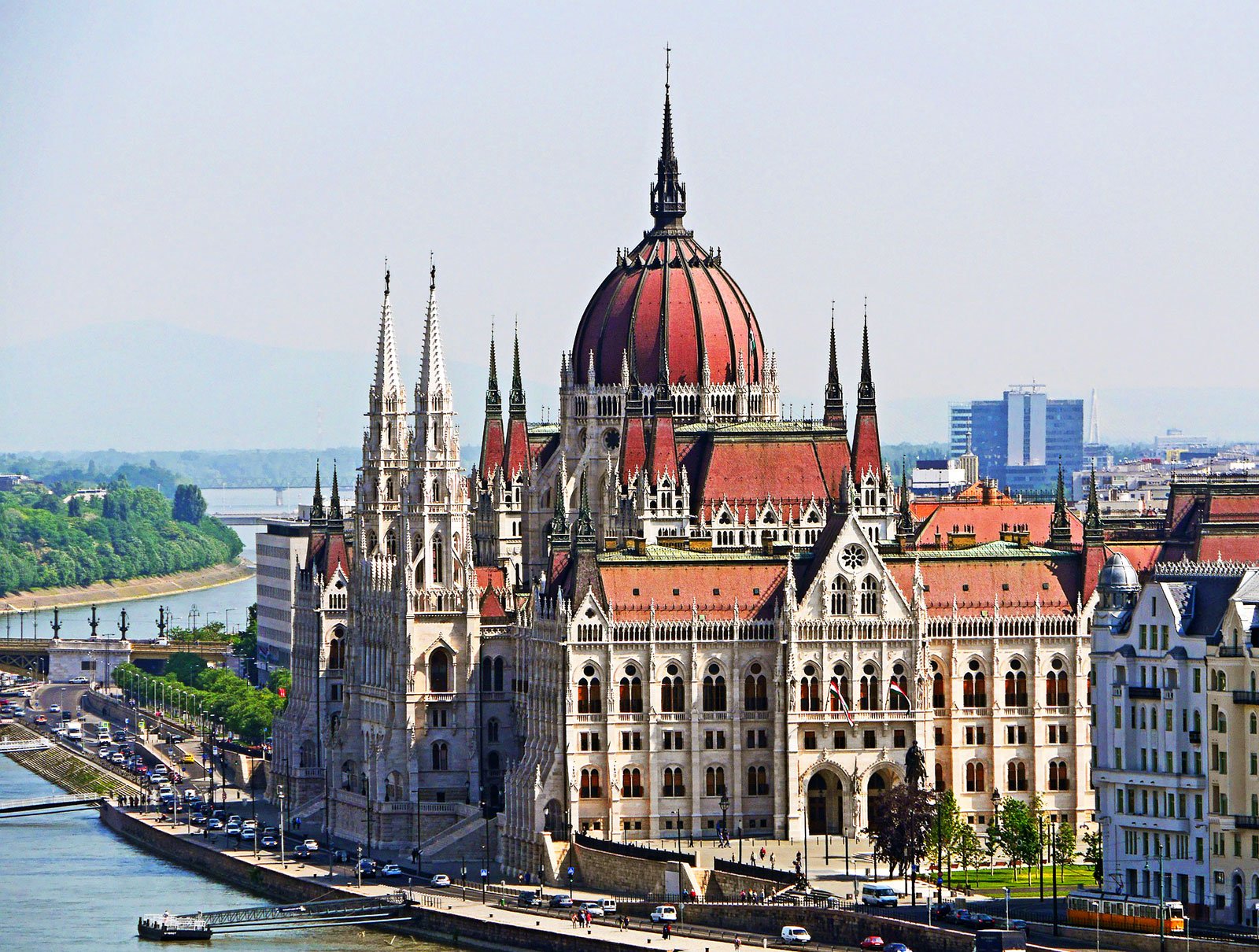
Margaret Island. I crossed the great iron girder bridge west of the Parliament buildings to return to my car. The bridge has tramway tracks in the middle and a stop in the middle of the bridge that gives access to Margaret Island, a large island in the middle of the Danube that is mostly park.
Millennium Monument. In Heroes’ Square, one of the major squares in Budapest, Hungary, noted for its iconic statue complex featuring the Seven chieftains of the Magyars and other important Hungarian national leaders, as well as the Memorial Stone of Heroes, often erroneously referred as the Tomb of the Unknown Soldier. The square has played an important part in contemporary Hungarian history and has been a host to many political events,
The central feature of Heroes’ Square, as well as a landmark of Budapest, is the Millennium Memorial. Construction began in 1896 to commemorate the thousandth anniversary of the Hungarian conquest of the Carpathian Basin and the foundation of the Hungarian state in 1896, The four allegoric sculptures were added in 1906. When the monument was originally constructed, Hungary was a part of the Austro-Hungarian Empire and thus the last five spaces for statues on the left of the colonnade were reserved for members of the ruling Habsburg dynasty. The monument was damaged in World War II and when it was rebuilt the Habsburgs were replaced by the current figures.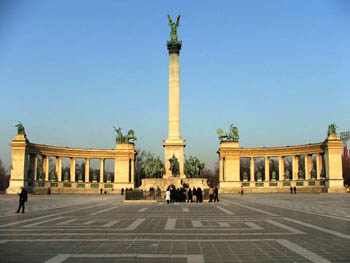
ING bank head office. In the NM “Modern Architecture Buildings” series.
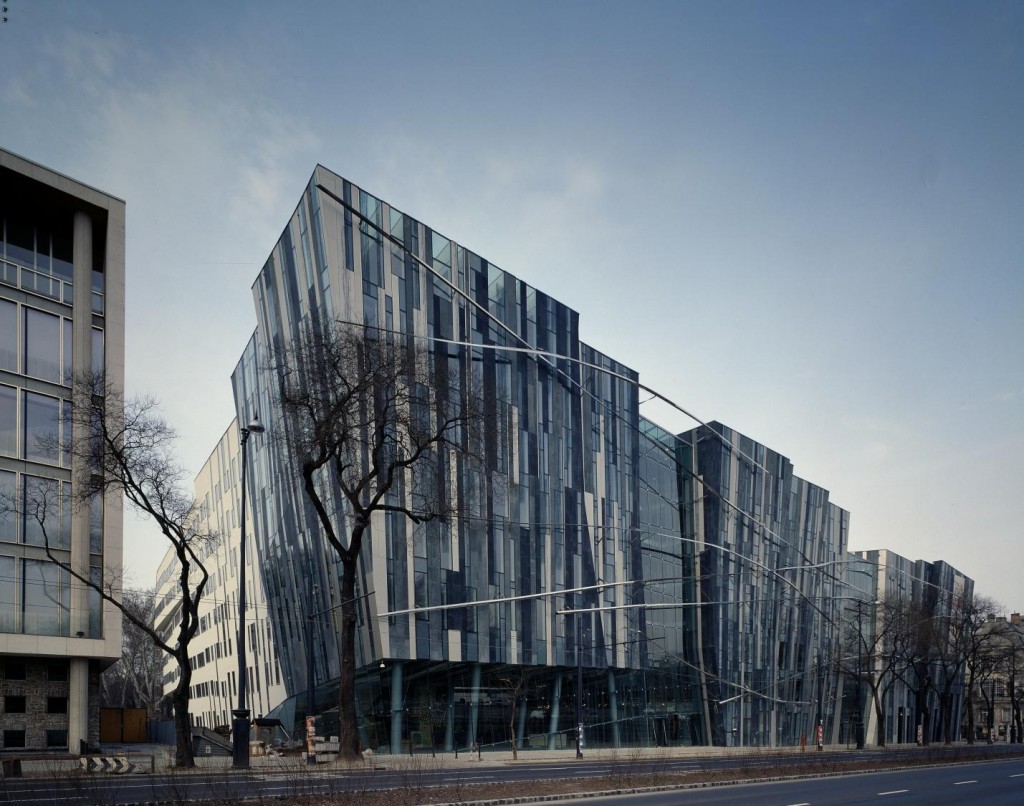
Memento Park. In both the NM “The Dark Side” and the “Open-Air Museums” series, monumental statues and sculpted plaques from Hungary’s Communist period (1949–1989). There are statues of Lenin, Marx, and Engels, as well as several Hungarian Communist leaders. This park is about dictatorship. And at the same time, because it can be talked about, described, built, this park is about democracy. After all, only democracy is able to give the opportunity to let us think freely about dictatorship.
Memento Park is divided into two sections: Statue Park, officially named “A Sentence About Tyranny” Park in 6 oval sections; and Witness Square (also called “Neverwas Square”), which lies east of the main park entrance and is visible without payment. Statue Park houses 42 of the statues/monuments that were removed from Budapest after the fall of communism. Witness Square holds a replica of Stalin’s Boots which became a symbol of the Hungarian Revolution of 1956 after the statue of Stalin was pulled down from its pedestal in 1956, and is flanked by two single storey timber structures housing the internal exhibition space, their design being evocative of simple internment camp buildings.
Need to buy the guide book for €5 to understand all the statues. In an odd forest setting. 1200 HUF
NOMAD MANIA Hungary – Central and North (Budapest, Miskolc, Szolnok, Eger)
World Heritage Sites
Budapest, including the Banks of the Danube, the Buda Castle Quarter and Andrássy Avenue
Caves of Aggtelek Karst and Slovak Karst
Old Village of Hollókő and its Surroundings
Tokaj Wine Region Historic Cultural Landscape
Tentative WHS
Caves of the Buda Thermal Karst System (11/08/1993)
Frontiers of the Roman Empire – Ripa Pannonica in Hungary (22/06/2009)
Ödön Lechner’s independent pre-modern architecture (26/05/2008)
The Ipolytartnóc Fossils (28/12/2000)
The Network of Rural Heritage Buildings in Hungary (28/12/2000)
Sights
Budapest Jewish Memorials
Diósgyőr Castle
Ecseri piac Flea Market
Eger Castle
Fisherman’s Bastion
Gödöllő Palace
Great Hall Market, Budapest
Kékes
Lillafüred Caves
Memento Park, Budapest
Szecheny/Gellert Thermal Baths
Szentendre
Borders
Hungary (river/lake border)
Hungary-Slovakia
XL: Aggtelek area
Railway, Metro, Funiculars, Cable Cars
Children Railway
Danube Express (Budapest-Istanbul)
Hungary Intercity Railway Experience
Railjet
House Museums/Plantations: Monok: Kossuth Memorial House
Castles, Palaces, Forts
Boldogkőváralja: Boldogko Castle
Fuzer: Fuzer Castle
Sirok: Sirok Castle
Religious Temples
Rackeve: Serbian Kovin Monastery
Vac: Assumption Cathedral
World of Nature
Aggtelek
Bukk
Festivals: Sziget
Entertainment/Things to do
Celeritas Shooting Club
House of Houdini
Sátoraljaújhely: Zemplén Adventure Park
TRAP Team Race Against Puzzles
Zoos: Budakeszi Wildlife Park
Botanical Gardens
Soroksár Botanical Gardens
Vácrátót: National Botanical Garden
Caves: Baradla cave
Ski Resorts
Bánkút Ski Resort
Kékestető Ski Resort
Open-Air Museums: Szigethalom: Emese Park
European Cities
BUDAPEST World Capital World City and Popular Town
World Heritage Sites: Budapest, including the Banks of the Danube, the Buda Castle Quarter and Andrássy Avenue
Airports: Budapest (BUD)
Islands
Csepel
Hajógyári
Railway, Metro, Funiculars, Cable Cars
Budapest Castle Hill Funicular
Budapest Keleti Railway Station
Budapest Metro
Budapest Nyugati Railway Station
Budapest tram
Museums
Aquincum Museum
Budapest Hall of Art
Budapest History Museum
Csodák Palotája Science Museum
Ethnographic Museum
Ference Hopp Museum of Asiatic Arts
Geological Museum
Goldberger Museum of Textile Industry
Hospital in the Rock
House of Hungarian Art Nouveau
Hungarian Electronic Museum
Hungarian House of Photography
Hungarian Jewish Museum and Archives
Hungarian Museum of Trade and Tourism
Hungarian National Gallery
Hungarian National Museum
Hungarian Natural History Museum
Hungarian Technical and Transportation Museum
Imre Varga Collection
Kalmar Art Studio
Kiscelli Museum
Koller Gallery
Kresz Géza Ambulance Museum
Ludwig Museum
Miniversum
Musée Lajos Kassák
Museum of Applied Arts
Museum of Fine Arts
Museum of Hungarian Agriculture
Museum of Military History
Robert Capa Contemporary Photography Center
Semmelweis Museum
Vasarely Museum
Zelnik Istvan Southeast Asian Gold Museum
Zwack Unicum Museum
House Museums/Plantations
Béla Bartók Memorial House
Imre Nagy Memorial House
Liszt Ference Memorial Museum
Miksa Róth Memorial House
Petőfi Literary Museum
Castles, Palaces, Forts
Buda Castle
Nagyteteny Castle (History of ‘Furniture Art’)
Sándor Palace
Vajdahunyad Castle
Religious Temples
Dohány Street Synagogue
Matthias Church
Orthodox Cathedral of Our Lady
St. Stephen’s Basilica
Modern Architecture Buildings
Hungarian Autoklub Headquarters
ING bank head office
National Theatre
Parliament Building
Entertainment/Things to do
Invisible Exhibition
Puskin Mozi
Urania National Film Theatre
Zoos: Budapest Zoo
Botanical Gardens: Botanic Garden
Aquariums: Tropicarium-Oceanarium
Planetariums: Budapest Planetarium
Theme Parks: Tarzan Park
Malls/Department Stores: Westend City Center
Hospitality Legends
Corinthia Grand Hotel Royal
Gerbeaud Café
Gundel Restaurant
Hotel Gellért
Matyas Pince Restaurant
Százéves Étterem Restaurant
Markets
Central Market Hall
Ecseri piac Flea Market
Feny Street Market
Szimpla Farmers’ Market (Sunday)
Monuments
Liberty Statue
Millennium Monument
Ronald Reagan Statue
Maritime/Ship Museums: SMS Leitha
Aviation Museums: Aeropark
Open-Air Museums: Memento Park
Railway Museums
Hungarian Railway History Park
Millennium Underground Museum
The Dark Side:
House of Terror
Memento Park
Shoes on the Danube Bank sculpture
Bizzarium: Budapest Pinball Museum
Festivals
Budapest Summer Festival
Budapest Wine Festival
Budapest: Budapest Fringe Festival
Budapest: Budapest Spring Festival
MISKOLC
Railway, Metro, Funiculars, Cable Cars: Miskolc Tram
Museums
Hungarian Museum of Technology
Museum of Theatre History and Performing Arts
Otto Herman Museum
Pannonian Sea Museum
Papszer Old Exhibition Building
Castles, Palaces, Forts: Diósgyõr Castle
Zoos: Miskolc Zoo
Festivals
Miskolc International Film Festival
Miskolc Opera Festival
SZOLNOK
Pedestrian Bridges: Tiszavirág bridge
Aviation Museums: Airplane Museum of Szolnok
Festivals: International Goulash Festival, Szolnok
Villages and Small Towns
Hollókő
LILLAFÜRED
Waterfalls
Lillafüred Waterfall (same as Szinva)
Szinva waterfall
Caves:
István Cave
Anna Cave
EGER
Museums: Eger: Astronomical Museum and Camera Obscura
House Museums/Plantations: Eger: Memorial Museum of Géza Gárdonyi
Castles, Palaces, Forts: Eger Castle
GÖDÖLLŐ
Museums: Museum of Agricultural Devices
Castles, Palaces, Forts: Royal Castle of Gödöllő
Botanical Gardens:Szent István University Gödöllő Botanical Garden
SZENTENDRE
Museums
Béla Czóbel Museum
National Wine Museum
Serbian Orthodox Museum
Transportation Museum
Vehicle Museums: Szentendre: Retro Design Center
Open-Air Museums: Szentendre: Hungarian open-air museum
SZERENCS
Museums: Szerencs: Zempleni Museum
TOKAJ
Museums: Tokaji museum
VISEGRAD
Tentative WHS: Mediaeval Royal Seat and Parkland at Visegrád (28/12/2000)
Museums
Matyas Kiraly Museum
Zugfozde Palinka Museum
Castles, Palaces, Forts: Visegrád Castle
Waterfalls: Devil’s Mill Waterfall
